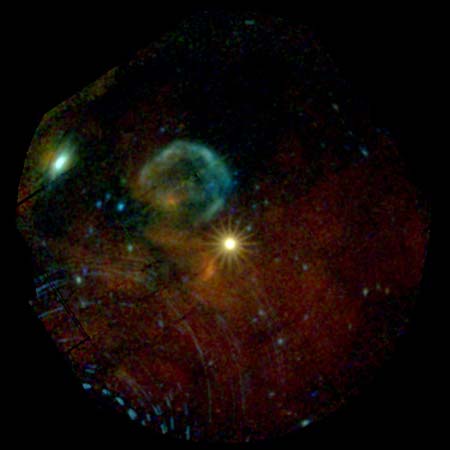The light of the supernova explosion SN 1987A continued to shine
Twenty years after the first observation of supernova explosion SN 1987A, this is the closest supernova explosion discovered since the telescope was invented, the XMM space observing center. Newton of the new European space agency provided the latest picture of the explosion. This space observation center confirmed that the light of this explosion continued to glow.
The supernova explosion SN 1987A is located in a large Magellanic cloud (the largest Magellanic cloud is a dwarf galaxy and the closest to our Milky Way) is the closest supernova supernova explosion discovered by us. since the telescope was invented. Nearly 20 years after it was discovered on February 23, 1987, the observatory XMM-Newton observed the rest of the explosion with X-rays on January 17, 2007. Its light continued. The glow since its discovery by the ROSAT satellite in 1992 has made its light brighter than any source of X-ray near it and is 10 times brighter than the light observed by telescopes. expected XMM-Newton in January 2000.
Supernova explosion SN 1987A is the only opportunity to study in detail the first stages of the rest of a supernova star.
Observing the entire electromagnetic spectrum provides a specific picture of the central lip near a star created by the star's wind of a giant star in its super-giant stages of development.

The color image of the sky surrounding the supernova explosion SN 1987A was taken by three EPIC cameras on the European Space Agency's XMM-Newton telescope on January 17, 2007. X with different energy intensity is indicated by red color with intensity of 0.2-1 keV (kilowatt-hour), 1-2keV green color and blue intensity of 2-4, 5 keV.Supernova explosion SN 1987A is the bright spot near the center of the image (Photo by the European Space Agency ESA).
The X-rays that we see are primarily made up of the interaction between the collision between the supernova explosion and this delicate central lip. The detailed analysis of these X-rays will give us a closer look at the physics of the explosion and it will probably reveal the appearance of a solid object in the center like a neutron star. .
Uyen Nhi
- The supernova of the wild cousin of SN 1987A
- The supernova explosion is 10.5 billion light-years away from Earth
- Create supernova explosions in the laboratory
- Build 3D core map of a supernova
- The supernova explosion is 55 million light-years from Earth
- The first evidence of the origin of cosmic dust formation
- Photos, videos and three-dimensional models of giant supernova
- Spectacular supernova explosions in the universe
- Witness the supernova explosion that seems to be only in sci-fi movies
- NuSTAR telescope helps decode supernova explosions
- Supernova origin
- Earth used to catch supernova dust
 Van Allen's belt and evidence that the Apollo 11 mission to the Moon was myth
Van Allen's belt and evidence that the Apollo 11 mission to the Moon was myth The levels of civilization in the universe (Kardashev scale)
The levels of civilization in the universe (Kardashev scale) Today Mars, the sun and the Earth are aligned
Today Mars, the sun and the Earth are aligned The Amazon owner announced a secret plan to build a space base for thousands of people
The Amazon owner announced a secret plan to build a space base for thousands of people Extraterrestrial Object 12,800 Years Ago Changed Humanity
Extraterrestrial Object 12,800 Years Ago Changed Humanity  The mystery of the Tunguska explosion may have been solved, the real cause was a drifting meteorite phenomenon
The mystery of the Tunguska explosion may have been solved, the real cause was a drifting meteorite phenomenon  Can cars really explode after a collision like in the movies?
Can cars really explode after a collision like in the movies?  3 natural disasters have not found the exact cause
3 natural disasters have not found the exact cause  Mystery of the biggest explosion in history, is it a message from space?
Mystery of the biggest explosion in history, is it a message from space?  Discover a new kind of explosion in the universe
Discover a new kind of explosion in the universe 